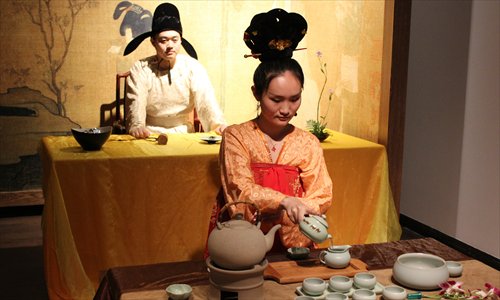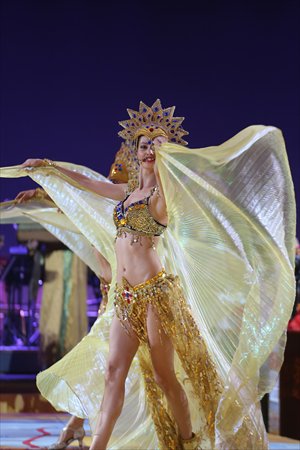Silken links

A tea ceremony is performed for visitors at the Tang West Market Museum. Photo: Xiong Yuqing/GT

Dancers perform on stage at the Silk Road International Expo. Photo: Courtesy of the Tang West Market Group
When thinking about the Silk Road most people's minds turn to the Sui (581-618) and Tang dynasties (618-907), a time when trade along the route was at its peak and many foreigners from Middle Asia and Europe were bringing their business and culture to the then capital city of Chang'an, or as it is known today Xi'an, in Northwest China's Shaanxi Province.
About 1,300 years ago, Chang'an's Xishi, or West Market, was the location of a huge international market, while the market located in the eastern side of the city focused on domestic wares. At the time the city was experiencing unprecedented prosperity when it came to cultural variety and trade.
Today, the West Market, now referred to as the Tang West Market, has become an area mixing historic culture and modern business with archaistic architecture sitting alongside buildings with a more contemporary style. However, even today it is still fulfilling its mission of linking Eastern and Western cultures together.
The Tourism and Culture Exhibition of Silk Road Countries & The 5th Exhibition and Performance of Western China Intangible Cultural Heritage together with The 18th China East-West Cooperation and Trade Fair and the Silk Road International Expo kicked off at the Tang West Market over the weekend bringing exhibitions and shows from provinces in Northwest China and countries along the Silk Road to the city.
These simultaneous events brought an atmosphere of extraordinary enthusiasm to the area, while experts from home and abroad came to attend different forums and promotional tourism events throughout the weekend.
Lü Jianzhong, chairman of the board of the Tang West Market Group, introduced the site to the media as an important historical hub for China and even the world.
"In addition to protecting the site, we can use the cultural value of the Tang West Market to develop the economy and tourism industry in Shaanxi, as well as international trade within the Silk Road Economic Zone," Lü added.
Journey of a thousand miles...
In 2007, the Tang West Market was verified by the National Bureau of Cultural Relics as the starting point of the Silk Road during the Sui and Tang. Now a museum dedicated to the original market has been built directly above the site of the ancient market, protecting and displaying the ancient traces of horses and carriages.
"To some extent, the ancient West Market resembles the Free Trade Zones we have now. It was here that ceramics, tea and silk were sold and transported abroad, while religion, culture and foreign goods were brought in and distributed throughout the entire nation," explained Lü.
According to Wang Bin, the curator of the Tang West Market Museum, this is the first private museum to be built directly above an ancient site, while also being the first privately funded second-tier museum in China.
A permanent exhibition at the museum shows the market and the lives of people during the Tang Dynasty.
"At that time Chang'an was the center of world trade, a place people around the world dreamed of. There were hundreds of industries in the market, and a mixture of different religions and culture. We wanted to present the most distinguished period of the Tang Dynasty based on the relics found here," explained Wang.
Wang said that although other places along the Silk Road could hold their own exhibitions, due to the fact that it all started here means this place has unique significance.
A glimpse into the past
Centering on the theme of the Silk Road, the museum holds different exhibitions presenting historical culture and related modern art work. In addition to the permanent exhibition, the main hall displays modern art work by contemporary Chinese artists. Meanwhile, on the third floor an exhibition about the currency used along the Silk Road delves into the history of other countries along the ancient trade route and how these currencies linked these ancient civilizations together.
During the opening ceremony of The Tourism and Culture Exhibition of Silk Road Countries & The 5th Exhibition and Performance of Western China Intangible Cultural Heritage, Wang signed cooperative agreements with 10 countries that sit along the ancient route, including the national museum of Kyrgyzstan. This is the first time the museum has come to China, bringing 100 Kyrgyz embroidery items that will be displayed at the Tang West Market Museum over the following three weeks.
"This is the first time they have cooperated with a Chinese museum and also marks the debut of their collection in China," said Wang.
Originally a deputy curator at the Shaanxi History Museum, Wang pointed out the advantages in freedom and efficiency private museums have over State-owned museums.
"When we brought our collection to Kyrgyzstan in April, the staff there hoped we could stay until May 18, International Museum Day. I was able to promise immediately that we would extend our exhibition. Being private makes things easy," said Wang.
Thriving heritage
The Tang West Market was also the location of an immense entertainment district during the Tang Dynasty, with a plethora of artists from home and abroad gathering in the city. Chinese poets such as Li Bai once described the amazing dances performed by foreign dancers from the West.
Nowadays the market continues to act as a stage for inheritors of intangible folk heritage. During the expo, artists and craftsmen from China's western provinces presented their skills at the market's square. Featuring global, State and provincial level intangible cultural heritage programs, the series of events attracted visitors and investors with its amazing and colorful performances, such as Dongcang drum music from Xi'an, Urtin Duu (long songs) from Inner Mongolia and Shaanxi's local Qinqiang Opera.
"Unlike other types of heritage, art is intangible and can only be inherited in its living form," prize winning Qinqiang Opera performer Li Mei told the Global Times, explaining the inherent difficulties in passing down intangible culture from one generation to the next.